First Look: IDW’s “Cobb” Evokes the Tough-Guy Action Flicks of the 70’s
By Sean Fahey
 IDW’s new mini-series Cobb: Off the Leash has the look and feel of 1970’s era action movie. That’s a good thing, by the way, for the uninitiated. Think Sam Peckinpah. Think Steve McQueen, James Colburn and Angie Dickinson. Unapologetic tough guys that don’t wallow in psychoanalytical bullshit to explain their actions. Knockout broads that are able to display their sexuality without it turning into a PC crisis. Bare knuckled, jaw breaking, pull no punches action. In a comic book landscape dominated by men-in-tights that seem to second guess everything they do, it’s refreshing to see a story about a good ol’ fashioned man of action.
IDW’s new mini-series Cobb: Off the Leash has the look and feel of 1970’s era action movie. That’s a good thing, by the way, for the uninitiated. Think Sam Peckinpah. Think Steve McQueen, James Colburn and Angie Dickinson. Unapologetic tough guys that don’t wallow in psychoanalytical bullshit to explain their actions. Knockout broads that are able to display their sexuality without it turning into a PC crisis. Bare knuckled, jaw breaking, pull no punches action. In a comic book landscape dominated by men-in-tights that seem to second guess everything they do, it’s refreshing to see a story about a good ol’ fashioned man of action.
The first in a three-part miniseries, Cobb # 1 is focused primarily on setting the stage for the non-stop adrenaline rush to follow. But that’s not to say that that this issue doesn’t have its share of action. In fact, when we first meet Cobb – a former secret service agent drifting around
From there, series writer Beau Smith invests his time in introducing the rest of the key players and kicking the plot into gear. As a condition of his release, Cobb is off to
Beau Smith and Eduardo Barreto compliment each other’s styles exceptionally well. Smith has a very direct writing style that is perfectly suited for this kind of action story. He doesn’t waste any time with exposition or a lot of wasteful talking heads banter (which, though all the rage these days, gets very tiresome after the fifth or sixth page), but instead keeps the action moving at an exciting pace, and ends the issue with a cliffhanger that leaves you dying for the next issue. And his characters are just cut from a different cloth than most modern comic book heroes – as I’ve said before, they’re right out of the era that produced “The Getaway” and “Point Blank.” The men are men, and the women are women. Barreto has a classic aesthetic to his work that is perfectly attuned to what Smith is doing here. It’s sharp but not overly stylized, and it’s detailed but not gratuitous. His tough guys look tough, and his women…brother, do they look like women.
Old school all the way.
RATING: 
The Secret Six of one, half a dozen of the other
by Graig
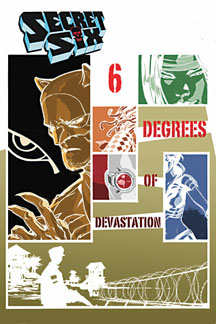 Of all the mini-series that led into Infinite Crisis, Gail Simone’s Villains United held together the best. She managed to take a handful of bad-guy characters few cared about (with the exception of Deadshot, everybody’s loved that guy since his Suicide Squad days) and inject them with vibrant personalities and a unique team dynamic. Hell, in 22-pages she turned one of Batman’s lamest adversaries, Catman, into one very cool character. I know I wasn’t the only one who thought there was a lot of potential in the team, and following the events of the Crisis, here we have their further exploits.
Of all the mini-series that led into Infinite Crisis, Gail Simone’s Villains United held together the best. She managed to take a handful of bad-guy characters few cared about (with the exception of Deadshot, everybody’s loved that guy since his Suicide Squad days) and inject them with vibrant personalities and a unique team dynamic. Hell, in 22-pages she turned one of Batman’s lamest adversaries, Catman, into one very cool character. I know I wasn’t the only one who thought there was a lot of potential in the team, and following the events of the Crisis, here we have their further exploits.
In the first issue of this 6-issue mini-series, Simone, having already firmly established the group, gives them an operational status quo. Like the A*Team meets the Suicide Squad, this group of mercenaries takes the tough jobs and gets out there and does them. In this case, they raid a North Korean prison camp in the name of revenge. But as quickly as Simone establishes the status quo, she decimates it. The Society (of super-villains) has lost Lex Luthor as leader, and now there’s a power stuggle to gain control. Dr. Psycho hasn’t forgotten the Six’s interference in their previous agenda, and he’s sent out a squad of nasties to take down each of them. And by the looks of the final pages, he just may have succeeded. Already the book starts off with only five members to the Secret Six, and by next issue there might be even less.
Sharp, humorous dialogue, clever set-up and a healthy dose of mystery are all key to the success of this book, and it all rests on Gail Simone’s shoulders. She’s absolutely hit the nail on the head with this one. Unfortunately, the nail bends in the art department. Dale Eaglesham, her Villains United partner is sorely missed here, with Brad Walker taking over pencilling duties.
I’m disappointed that the weaker Day of Vengeance team, the Shadowpact, got spun off into an ongoing series and the Secret Six are only getting the mini-series treatment, but if this issue is any judge it’s only a matter of time.
RATING: 
Face Front, True Believer—Karl Kesel’s Got the True Stan Lee Spirit in “Fantastic Four: A Death in the Family”!
By Jeb D.
 The great question about this comic isn’t so much whether it’s good or bad, so much as what’s it doing here? At a time when Ben Grimm can’t carry his own book, and the FF themselves are being drawn into Marvel’s Civil War, the purpose of a standalone adventure with no real ties to existing continuity seems murky, at best. What it feels like, more than anything else, is the kind of “fill-in” story that Marvel and DC used to keep on the shelf for the day when a book was running late (nowadays, of course, they just delay them till they’re ready, and you can decide for yourself which approach you prefer).
The great question about this comic isn’t so much whether it’s good or bad, so much as what’s it doing here? At a time when Ben Grimm can’t carry his own book, and the FF themselves are being drawn into Marvel’s Civil War, the purpose of a standalone adventure with no real ties to existing continuity seems murky, at best. What it feels like, more than anything else, is the kind of “fill-in” story that Marvel and DC used to keep on the shelf for the day when a book was running late (nowadays, of course, they just delay them till they’re ready, and you can decide for yourself which approach you prefer).
What you get for your $3.99: the new 22-page story, “A Death in the Family”, a reprint of John Byrne’s Sue Richards-centric “Childhood’s End”, from FF #245 (a time, one notes from the cover, when Sue was still the Invisible “Girl”), and another installment of Chris Eliopolous and Marc Sumerak’s humorous “Franklin Richards” strip.
Karl Kesel’s story itself is pretty interesting: it is the closest thing I’ve seen to a Stan Lee FF story in many years. In fact, if it had come out during Stan’s heyday, it would have had banners all over the cover screaming “Not an Imaginary Story!! In this issue, one of the FF dies!!!”. And, basically, that’s true. Now, given that I’ve already said that the story doesn’t really affect existing Marvel continuity, it’s pretty clear that this results in no real long-term change in the team’s status quo. But for all that, it’s a charming piece that, apart from the less-flowery dialog, really recaptures the kind of family-focused tale that was (along with the Galactus-style epic) the FF’s great contribution to superhero storytelling. To tell many of the specifics would really spoil the storyline: suffice to say that the first panel is Reed cradling a dying Sue in his arms, with Ben and Johnny looking on, horrified. The book then takes us back “one hour earlier” to the setup, and takes off from there, and by the end, you may feel the story was a bit slight, but you certainly won’t feel cheated—Kesel really plays fair.
Lee Weeks’ art is perfectly serviceable, even with two inkers each doing half the book (I’d say that colorist J. Brown could have brightened the palette just a bit). It’s interesting, though, that as fondly as John Byrne’s run on the title is remembered, his conventional panel arrangement seems almost stodgy next to the variety of grids and layouts that Weeks employs. That Byrne is justly considered one of the greats of the post-Kirby era, while Weeks is a well-regarded journeyman, speaks volumes towards the degree to which the bar has been raised for superhero comic art in the past few years.
As to the final feature, I have trouble evaluating the “Franklin Richards” strips: they are SO derivative of “Calvin and Hobbes” that I almost feel insulted by the idea, but I have to admit that they always give me a chuckle, and this one’s no different. The book ends with a dense, 3-page history of the FF (presuming that the “Death in the Family” title was likely to recruit new readers?).
Worth your $3.99? Eh, hard to say. I certainly enjoyed it, but in a thoroughly nostalgic way. If you don’t get the same warm glow from the FF of the 60’s that I do, then you might want to skip it, particularly if the other features don’t interest you. But if you’re as much of an old-schooler as I am, or don’t have the Byrne reprint, or are collecting the “Franklin Richards” strips, then I say go for it.
RATING: 
The Last Christmas: It’s like Christmas in July… in May…?
by Graig Kent
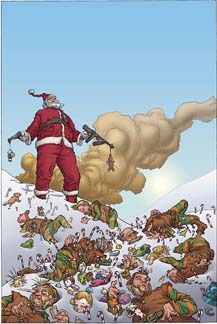 Okay, what the…? Seriously. Why is there a book with Santa Claus on the cover appearing on the stands in May? Is it a clever marketing ploy, a curiousity killed the cat kind of thing? Or is the book just greatly delayed and only hitting the stands now? Well, who knows. My suspicions are that perhaps the summer is the best time to watch the world go to hell after nuclear fallout, see Santa’s workshop get decimated by marauding radioactive mutants, and watch jolly ol’ St. Nick fall completely to deranged, suicidal pieces.
Okay, what the…? Seriously. Why is there a book with Santa Claus on the cover appearing on the stands in May? Is it a clever marketing ploy, a curiousity killed the cat kind of thing? Or is the book just greatly delayed and only hitting the stands now? Well, who knows. My suspicions are that perhaps the summer is the best time to watch the world go to hell after nuclear fallout, see Santa’s workshop get decimated by marauding radioactive mutants, and watch jolly ol’ St. Nick fall completely to deranged, suicidal pieces.
Did I mention this is a funny book? I don’t mean funny book like my grandmother calls all comics "funnybooks", I mean, this is supposed to be a slice of comedy. If you think Santa saying "Ho Ho Holy Shit!" or sitting in his boxer shorts and slathering himself with Mrs. Butterworths and then jumping out of his sleigh at a few hundred feet is funny, then this is your kind of book.
It may not sound very festive, but if you like dark, goofy, conceptual comedy, this is right up your alley. Written by screenwriter Gerry Duggan and Mr. Show’s Brian Posehn, the book stays away from punchlines but stays true to its concept of a world, and ultimately a North Pole, truly gone to hell. The first of a six-part series (the trade could be out in time for Christmas!), we’re obviously watching the birth of a new, rougher, meaner Santa… a Santa who’s getting ready to go on the warpath and fight for, well, whatever a drunken, suicidal Santa still believes in. The only real misstep is the narrating snowman, who seems to pop up to exposit but serves more as a distraction.
Rick Remender and Hilary Barta juxtapose cartoony with dark, dark shadows, which mirrors the story perfectly. The colors by Michelle Madsen are a bit gloomy and muted, which does serve the story, but the book might be a bit more enticing with more vibrant colors (like those on Geoff Darrow’s cover).
I wasn’t too sure about this book, but once Duggan, Posehn and crew got rolling with the concept, it did result in some guilty fun, which I’m sure will only grow in the coming issues.
RATING: 
Outrageous Conan Parody “Thrud the Barbarian” Will Bust Your Gut and Smash Your Skull
By Sean Fahey
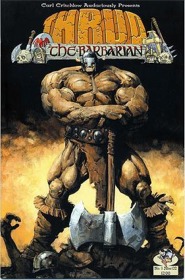 File this one under pleasant surprise, readers. Though it’s rare that I’ll pick up anything that I haven’t pre-ordered or set aside in my pull slip, I always take the time to peruse the shelves at my local comic shop. That’s part of what makes Wednesdays fun, right? Plus, you never know what you might found. Well, this Wednesday I found Thrud the Barbarian – three-hundred pounds of muscle, battleaxe in hand, threatening to smash my soul if I didn’t give his comic book a try.
File this one under pleasant surprise, readers. Though it’s rare that I’ll pick up anything that I haven’t pre-ordered or set aside in my pull slip, I always take the time to peruse the shelves at my local comic shop. That’s part of what makes Wednesdays fun, right? Plus, you never know what you might found. Well, this Wednesday I found Thrud the Barbarian – three-hundred pounds of muscle, battleaxe in hand, threatening to smash my soul if I didn’t give his comic book a try.
Thrud the Barbarian is to Robert E. Howard what “Tripping the Rift” is to George Lucas, an outrageous romp that is equal parts homage and parody. A true force of nature, Thrud, destroys everything in his path, whether by design or by accident. Imagine an albino Hulk with a battleaxe and a penchant for ale…but more of a bumbling colossus. Having mistaken a group of knights on a rescue mission as bandits, in Thrud the Barbarian # 1, our titular hero – through a series of slapstick events – inadvertently allows himself to be drawn into the knight’s quest and a conspiracy to overthrow the kingdom of Carborundum. Much – and I mean much – mayhem ensues.
Though not the most original idea in the world, (it is after all a parody) the appeal of this book is that is unapologetically over the top in every respect. Thrud is a tank with a head, and levels everything in sight and grossly misreads every situation he’s in. It’s mindless at times, but damn if it isn’t absolutely hilarious. Series writer and artist Carl Critchlow (whose visual style reminds me of Keith Giffen’s work on Trencher) is obviously having the time of his life working on this book, and his enthusiasm shows. And while Thrud is primarily a comedy, the action sequences here are pretty damn good in and of themselves. That they are so over the top, (manic flurries of decapitations, amputations, and skull crushings) makes them that much more amusing. A bloody good time.
RATING: 
![]()

Scott Pilgrim & The Infinite Sadness (Scott Pilgrim Vol.3)
Oni Press
by Graig Kent
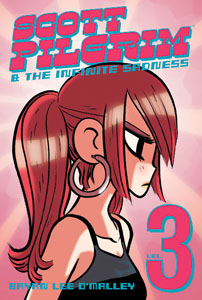 For those coming in late in the game, the skinny is this: Scott Pilgrim is on a quest to make Ramona Flowers his girlfriend, but in order to do so he first must defeat the seven evil ex-boyfriends. The latest challenge is Todd Ingram, who happens to be the bassist in the same band as Scott’s ex-girlfriend, Envy Adams, the woman who broke his heart. But it doesn’t stop there, secret trysts, hidden crushes, stalker-ish obsessions and other such romantic entanglements are all thrown into the mix. Take The O.C. and set it in the thick of Toronto’s indie music scene, add in a healthy dosage of Anime-inspired superpowers, video games-turned-real life inspirations, and a total slacker sense of humour, and that’s Scott Pilgrim.
For those coming in late in the game, the skinny is this: Scott Pilgrim is on a quest to make Ramona Flowers his girlfriend, but in order to do so he first must defeat the seven evil ex-boyfriends. The latest challenge is Todd Ingram, who happens to be the bassist in the same band as Scott’s ex-girlfriend, Envy Adams, the woman who broke his heart. But it doesn’t stop there, secret trysts, hidden crushes, stalker-ish obsessions and other such romantic entanglements are all thrown into the mix. Take The O.C. and set it in the thick of Toronto’s indie music scene, add in a healthy dosage of Anime-inspired superpowers, video games-turned-real life inspirations, and a total slacker sense of humour, and that’s Scott Pilgrim.
It’s so hard to be critical of something when you enjoy it so much. This title carries with it both hipster and geek caché, suitable for both the indie rock scene and the irony-free manga shelf. Though cleverly masked by all the geek jokes, fight scenes and rock’n’roll, Scott Pilgrim is a fightin’-for-her-heart love story, and is as equally a comfortable fit in the hands of a grade eight girl as it is in the hands of a 27-year-old wannabe rock star.
If there’s one poblem I have with the book, it’s Bryan Lee O’Malley’s character design. O’Malley has an overly simplified drawing style when it comes to his character faces (his wardrobe and settings capture the streets of Toronto perfectly) that it’s often difficult to distinguish who is whom. It also doesn’t help when characters hairstyles are changed within the same issue (their hair is usually the most defining feature). This third book jumps in and out of flashbacks with younger versions of the characters, which can be disorienting and confusing, leaving the reader needing a reference point to return to in order to visually identify them.
As a stand-alone book, O’Malley is a strong enough storyteller to flawlessly incorporate hints about what has gone on previously that a new reader shouldn’t be left in the dark without sacrificing pacing or flow, but picking up the third volume first would just be robbing you of the fun and entertainment of the first two books.
RATING: 
The Kindaichi Case Files: Playing The Fool
(Tokyopop)
by Elgin Carver
 Upon first reading Scott McCloud’s Understanding Comics, it seems an interesting intellectual exercise, but one which is pointless, as the reading of comics seems as natural and understandable as any other type of reading. The meaning of spaces between panels and picture fragments and the other subjects covered in that book seems a kind of college thesis type of inanity. Tokyopop has two types of manga books, one of which they call 100% authentic manga that reads as it does in Japan, from what we consider the back of the book to the front and from the right side of the page to the left. The Kindaichi Files series are books of this type and reading them quickly demonstrates the reality and utility of McCloud’s book. The inexperienced reader of authentic manga has to stop and consider each panel, where to go next, and what happens between each panel. Add to the mix the cultural differences and those manga facial expressions that can seem so inappropriate, and the reading experience becomes even more interesting.
Upon first reading Scott McCloud’s Understanding Comics, it seems an interesting intellectual exercise, but one which is pointless, as the reading of comics seems as natural and understandable as any other type of reading. The meaning of spaces between panels and picture fragments and the other subjects covered in that book seems a kind of college thesis type of inanity. Tokyopop has two types of manga books, one of which they call 100% authentic manga that reads as it does in Japan, from what we consider the back of the book to the front and from the right side of the page to the left. The Kindaichi Files series are books of this type and reading them quickly demonstrates the reality and utility of McCloud’s book. The inexperienced reader of authentic manga has to stop and consider each panel, where to go next, and what happens between each panel. Add to the mix the cultural differences and those manga facial expressions that can seem so inappropriate, and the reading experience becomes even more interesting.
This is the twelth of thirteen mysteries involving a teenage genius who happens to be the grandson of Japan’s greatest detective. It is a surprisingly well constructed mystery involving a variety of people stranded at a skiing lodge during a blizzard. Clearly owing quite a bit to Agatha Christie’s Ten Little Indians and harkening back to the Hardy Boys and Nancy Drew books, it still reads well for older fans. There are puzzles within mysteries and each time it seems that the genius can be beaten by the reader a logical yet confusing twist appears.
This is a satisfying read and one can probably presume that others in the series are as well constructed. Those unused to manga will find these a good introduction with enough familiar content to make them easy to pick up, with quality enough to keep one from wanting to put it down, and a welcomed absence of those fantasy elements so much of the genre seems to insist on including.
RATING: 
Star Wars: Clone Wars Adventures Volume 5
(Dark Horse Comics)
By Sean Fahey
 I’m a huge fan of the “Clone Wars” animated series, and think that its stylized visual aesthetic and hyper-kinetic pacing is the freshest thing to happen to the Star Wars universe since the original trilogy. Naturally, I’m also a fan of Dark Horse Comics’ digest-sized Clone Wars anthologies – with original stories told in the same bite-sized format as the cartoon. Par for the course, Clone Wars Adventures Volume 5 offers an eclectic collection of stories that cover a broad spectrum of the prequel universe, all beautifully rendered by the Fillbach Brothers.
I’m a huge fan of the “Clone Wars” animated series, and think that its stylized visual aesthetic and hyper-kinetic pacing is the freshest thing to happen to the Star Wars universe since the original trilogy. Naturally, I’m also a fan of Dark Horse Comics’ digest-sized Clone Wars anthologies – with original stories told in the same bite-sized format as the cartoon. Par for the course, Clone Wars Adventures Volume 5 offers an eclectic collection of stories that cover a broad spectrum of the prequel universe, all beautifully rendered by the Fillbach Brothers.
The lighthearted vignette “What Goes Up…” follows Jedi Aayla Secura as she investigates the mysterious disappearance of a number of her soldiers on Endor, with the help of a wise-cracking battle droid. “Bailed Out” features Senator Bail Organa leading a cloak-and-dagger rescue operation on Metalorn (as well as a special appearance by none other than fan favorite Wat Tambor!!). The popular commando ARC troopers prove their mettle in “Heroes on Both Sides,” and a young Jedi’s loyalties are tested in “Order of Outcasts.”
Like most of the previous Clone Wars Adventures stories, (as well as the animated series) the majority of the stories here are best described as bittersweet, and I think this adds a level of maturity to the work that most people probably don’t expect is there. Make no mistake, the Clone Wars Adventures is an all ages read. But the stories are always very conscious of the ramifications of war, loss, betrayal and the conflicting loyalties that are pervasive during this period of the Star Wars mythology. The action is wonderfully hyper-realistic, but each story is about more than just the action. Too bad these digest only come out once every couple of months.
RATING: 
The Murder Of Abraham Lincoln
(NBM Comics Lit)
By Elgin Carver
 In the 1960s the great humor magazine National Lampoon included a comics section in each issue that featured artists who were distinctive and above average. Most of them , inexplicably, never caught on with the comic book community. Rick Geary was one of these. Quirky and distinctive, his single page strip jumps off the page. Influenced by Edward Gorey, one of the truly oddball illustrators of the last generation, but with his own unusual style, his strip and the others made that magazine a must-read each month. While his strips are collected in a volume titled Housebound With Rick Geary, his work is otherwise hard to find. He did a few of the Classics Illustrated books in the short lived attempt by Acclaim Books to revive that series in a digest size. More easily found, and truer to his style, is the Treasury Of Victorian Murder series of which The Murder Of Abraham Lincoln is one.
In the 1960s the great humor magazine National Lampoon included a comics section in each issue that featured artists who were distinctive and above average. Most of them , inexplicably, never caught on with the comic book community. Rick Geary was one of these. Quirky and distinctive, his single page strip jumps off the page. Influenced by Edward Gorey, one of the truly oddball illustrators of the last generation, but with his own unusual style, his strip and the others made that magazine a must-read each month. While his strips are collected in a volume titled Housebound With Rick Geary, his work is otherwise hard to find. He did a few of the Classics Illustrated books in the short lived attempt by Acclaim Books to revive that series in a digest size. More easily found, and truer to his style, is the Treasury Of Victorian Murder series of which The Murder Of Abraham Lincoln is one.
This series of books, of consistent size, although half are hard bound, examines either a murder or murderer from the 1800’s that is unsolved or so famous as to still attract attention. So far Geary has looked at Jack the Ripper, Lizzie Borden, President Garfield, H. H. Holmes a serial killer in Chicago, and Mary Rogers a murder victim from New York. His style of heavy black lines with no halftone shading often jumps from place to place with wildly varing viewpoints. Panels are sometimes composed in an oddly truncated manner or with static scenes that remind one of Japanese filmmakers’ attraction to the peripheal. God’s-eye views of the countryside give a clear and factual outline of the events in question. No doubt his heartland origin aids in both his clear view and his style.
What seems to be meticulious research brings about a look at history that is intersting even when obscure. Here, where the facts are presumably well known to the reader, the methodical walk through the observations contemporaneously recorded leaves little to the imagination. Lincoln is one of the most complex people in history. Literally hundreds of thousands of extensive biographies have been written about this man. The vast majority have been able to find some part of his psyche or action that no one else has ever looked at. This book covers no new ground but does uniquely illuminate what happened on the last day of his life, and what led up to it from the viewpoint of both the President and his killer. It is hard to over recommend this artist’s work, and this series in particular. It would be extremely interesting to see his take on superheroes (the Hulk springs to mind) and if Mike Allred can do it, why not Rick Geary.
These books are easily available through Amazon and can probably be ordered by your local comic shop or book store.
RATING: 
![]()

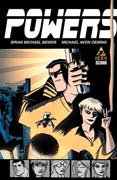 Powers #18 (Marvel). More great interrogation scenes? Why not? This time, Brian Bendis works a hilarious variation as Agent Lange harangues the only witness to the death of Millenium, accusing her of holding back information that’s really “out of this world.” Bendis also brings in a special guest star (a well-known “monkey boy”), and manages to tie in the whole “stand-up comedy” framing device that the current arc has been using. Something happens that actually brings a smile to Walker’s face, which is immediately undercut by Pilgrim’s chilling moment of truth with herself. It’s almost pointless to continue praising Mike Oeming’s art on this title: Powers, in anything like its current form, is unimaginable without him. – Jeb D.
Powers #18 (Marvel). More great interrogation scenes? Why not? This time, Brian Bendis works a hilarious variation as Agent Lange harangues the only witness to the death of Millenium, accusing her of holding back information that’s really “out of this world.” Bendis also brings in a special guest star (a well-known “monkey boy”), and manages to tie in the whole “stand-up comedy” framing device that the current arc has been using. Something happens that actually brings a smile to Walker’s face, which is immediately undercut by Pilgrim’s chilling moment of truth with herself. It’s almost pointless to continue praising Mike Oeming’s art on this title: Powers, in anything like its current form, is unimaginable without him. – Jeb D.
RATING: 
 Marvel Milestones: Black Panther, Storm & Ka-Zar (Marvel) – With the Black Panther’s wedding to Storm on the horizon, Marvel has put out an issue of “Marvel Milestones” that takes a look back at two Storm/T’Challa adventures – one from January 2001 (“Black Panther” #26) and the second from December, 1980 (“Marvel Team-Up” #100) – and, inexplicably, partnered them with a similarly jungle-themed “Ka-Zar” adventure from a May, 1940 issue of “Marvel Mystery Comics.” The verdict? If it wasn’t for Reginald Hudlin, the Black Panther would be just one more supremely throwaway hero from the Marvel Universe. “Black Panther” #26 takes place in the middle of a ‘cosmic’ plotline and is present to simply indicate that Storm and T’Challa have hung out before, but we get that from the yes-I’m-the-undercard “Marvel Team-Up” 100 that actually holds up as a somewhat solid (albeit brief) anti-apartheid story. With John Byrne’s pencils, T’Challa is being attacked by white South Africans who want to take him prisoner back to South Africa. Storm intervenes and the two kick Afrikaaner ass. Short and sweet, but fine – with a tag that implies their attraction even then. The “Ka-Zar” adventure on the other hand, is just a strange throwback. Nothing really here except a reminder of how good “Black Panther” finally is. – Mark
Marvel Milestones: Black Panther, Storm & Ka-Zar (Marvel) – With the Black Panther’s wedding to Storm on the horizon, Marvel has put out an issue of “Marvel Milestones” that takes a look back at two Storm/T’Challa adventures – one from January 2001 (“Black Panther” #26) and the second from December, 1980 (“Marvel Team-Up” #100) – and, inexplicably, partnered them with a similarly jungle-themed “Ka-Zar” adventure from a May, 1940 issue of “Marvel Mystery Comics.” The verdict? If it wasn’t for Reginald Hudlin, the Black Panther would be just one more supremely throwaway hero from the Marvel Universe. “Black Panther” #26 takes place in the middle of a ‘cosmic’ plotline and is present to simply indicate that Storm and T’Challa have hung out before, but we get that from the yes-I’m-the-undercard “Marvel Team-Up” 100 that actually holds up as a somewhat solid (albeit brief) anti-apartheid story. With John Byrne’s pencils, T’Challa is being attacked by white South Africans who want to take him prisoner back to South Africa. Storm intervenes and the two kick Afrikaaner ass. Short and sweet, but fine – with a tag that implies their attraction even then. The “Ka-Zar” adventure on the other hand, is just a strange throwback. Nothing really here except a reminder of how good “Black Panther” finally is. – Mark
RATING: 
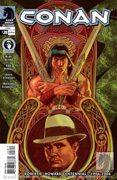 Conan # 28 (Dark Horse Comics) – The latest issue of Conan is a bit of milestone for the series in several respects. First, it marks writer Kurt Busiek’s last issue before Tim Truman takes over next month. But more importantly, this issue celebrates the centennial of Conan creator Robert E. Howard. A stand-alone one-shot titled “The Storyteller,” Busiek pays homage to Howard by making the story’s lead character a day dreaming farmer that entertains his village with wild tales of brave warriors and distant lands. When Conan and his companions show up at the village – on the run from a horde of demons – the storyteller finally gets a chance to live the adventure that existed only previously in his imagination. In an inspired move, Eric Powell fills in as the guest artist for this issue, and his pulp-influenced style evokes the timeless visual aesthetic of the genre. A fitting tribute to one of (if not the) great fantasy writers. – Sean
Conan # 28 (Dark Horse Comics) – The latest issue of Conan is a bit of milestone for the series in several respects. First, it marks writer Kurt Busiek’s last issue before Tim Truman takes over next month. But more importantly, this issue celebrates the centennial of Conan creator Robert E. Howard. A stand-alone one-shot titled “The Storyteller,” Busiek pays homage to Howard by making the story’s lead character a day dreaming farmer that entertains his village with wild tales of brave warriors and distant lands. When Conan and his companions show up at the village – on the run from a horde of demons – the storyteller finally gets a chance to live the adventure that existed only previously in his imagination. In an inspired move, Eric Powell fills in as the guest artist for this issue, and his pulp-influenced style evokes the timeless visual aesthetic of the genre. A fitting tribute to one of (if not the) great fantasy writers. – Sean
RATING: 
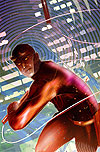 Daredevil #85 (Marvel). One of the great things that Brian Bendis did with this title was to make Daredevil’s somewhat lame “rouges’ gallery” into a series of formidable adversaries (remember, The Kingpin had originally been a Spider-Man foe). Now that Matt Murdock’s in stir with many of them, there’s a sense of menace that might have been missing if, say, The Owl was still the goofy-looking clown he was originally. As sides are drawn in the simmering prison, the new element in the mix is The Punisher: Frank Castle’s allowed himself to be locked up with Matt, as he puts it: “to see what it looks like when you turn into me.” And while Matt deals with the uncomfortable implications of that, Ben Urich and JJ Jameson are at each other’s throats, Dakota North may be getting herself in over her head, and in the background, we’ve still got the “new” Daredevil on the loose. Writer Ed Brubaker and artists Michael Lark & Stefano Gaudiano weave the threads effectively, with the various storylines coming together in a way that feels completely organic. It seems like Foggy Nelson’s fate was just the beginning. A completely gripping read. – Jeb D.
Daredevil #85 (Marvel). One of the great things that Brian Bendis did with this title was to make Daredevil’s somewhat lame “rouges’ gallery” into a series of formidable adversaries (remember, The Kingpin had originally been a Spider-Man foe). Now that Matt Murdock’s in stir with many of them, there’s a sense of menace that might have been missing if, say, The Owl was still the goofy-looking clown he was originally. As sides are drawn in the simmering prison, the new element in the mix is The Punisher: Frank Castle’s allowed himself to be locked up with Matt, as he puts it: “to see what it looks like when you turn into me.” And while Matt deals with the uncomfortable implications of that, Ben Urich and JJ Jameson are at each other’s throats, Dakota North may be getting herself in over her head, and in the background, we’ve still got the “new” Daredevil on the loose. Writer Ed Brubaker and artists Michael Lark & Stefano Gaudiano weave the threads effectively, with the various storylines coming together in a way that feels completely organic. It seems like Foggy Nelson’s fate was just the beginning. A completely gripping read. – Jeb D.